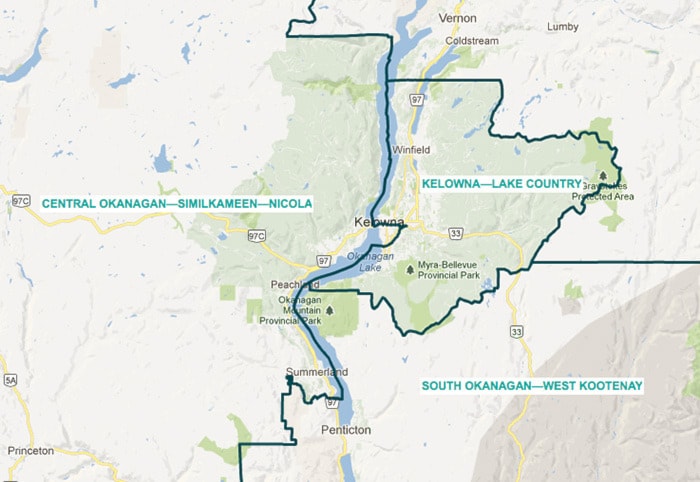Update: This story has been corrected to fix an inaccuracy regarding into which new riding Keremeos would fall. As well, B.C. Southern Interior MP Alex Atamanenko provided the following comment by email after the story went to press and online:
"I am extremely disappointed at the electoral boundary report. It obviously shows that the Commissioners did not listen to the overwhelming majority of those that presented at the hearings. Specifically, it makes absolutely no sense to separate Nelson, Trail and Castlegar. Also, it is my understanding that Penticton and Summerland wanted to stay together. I will be using whatever means I have at my disposal in Parliament to fight this."
*************
Numbers shouldn’t be the deciding factor for determining how Canada’s federal electoral boundaries are redrawn, say local politicians who are upset with a plan to sever the historical tie between Penticton and Summerland.
Canada’s soon-to-be 338 federal ridings are drawn so that the population in each is about the same. The map is studied once a decade by commissions in each province and adjustments made to accommodate population growth.
The proposed new map for B.C., which was tabled Monday in the House of Commons, adds six new ridings and dramatically recasts the Southern Interior.
Most notably, Penticton, Oliver, Osoyoos and Keremeos would join with Trail and Castlegar to form the new South Okanagan-West Kootenay riding, which would stretch north to include Nakusp.
Summerland would then fall in with Peachland, part of Kelowna, Merritt and Princeton in a new riding called Central Okanagan-Similkameen-Nicola.
Penticton Mayor Dan Ashton noted the new ridings would split Summerland and Penticton for the first time ever just to balance population numbers.
“These lines to me are wrong,” he said. “This is the issue when you have to attach numbers to it and draw lines based on numbers. They should be drawn based on trade… and commonalities, and they’re not.”
The electoral quota on which the new ridings are based is 104,763 people, and in the Southern Interior the new ridings vary from that by as much as 15 per cent. Summerland Mayor Janice Perrino thinks an exception should also be made to keep her community connected to Penticton.
“We’re talking about 11,000 people,” she said. “I would hardly call it huge.”
Besides obvious links in the administration of education and health care, Perrino added, the two cities also benefit from being able to lobby a single member of Parliament.
The new boundaries will be studied this spring by a House of Commons committee that will accept MPs’ written objections, which will then be sent back to the commissions for consideration. The final realignment will be submitted to Canada’s chief electoral officer in September.
John Hall, who chaired the B.C. commission, said his group will consider further changes based on input from MPs.
“We look at everything. You can’t not listen to people, in my opinion,” he said.
Hall noted, however, that while his commission heard loud and clear at public hearings last fall that there were concerns with the Penticton-Summerland split, it couldn’t find a workable solution to meet the electoral quota.
“All I can say about Summerland is it remains not the ideal solution from the point of view of some people in Summerland, but I think it would be less ideal to lump them in with the West Kootenays,” he said.
Okanagan-Coquihalla MP Dan Albas said he also found “some areas of concern” in the proposal and will work with colleagues to persuade the commission to “fine-tune” the boundaries to better reflect community input and address “accessibility issues” for people in the more far-flung areas of the new ridings.
The biggest change to Albas’s current riding would be the addition of part of Kelowna, plus Princeton and the area south to the Canada-U.S. border.
The Conservative MP, who recently moved from Penticton to West Kelowna, would not comment, however, on which riding he might contest in the next election, scheduled for October 2015.
“I’ve not even made the decision that I’m going to stand again for re-election,” Albas said.
B.C. Southern Interior MP Alex Atamanenko is in Russia on a trade mission and unavailable for comment. Under the new alignment, however, the NDP politician would lose Nelson, a party stronghold, to the Kootenay-Columbia riding.
That would hurt his chances for re-election, said political observer Wolf Depner.
Atamanenko “is going to be in a much tougher spot now. If Nelson falls out of his riding, that’s a good chunk of his vote there,” said Depner, a former journalist who’s now a doctoral candidate in political science at UBC-Okanagan.
Albas, he added, “would be the odds-on favourite” wherever he runs thanks to Conservative party backing and a higher profile from his successful bid last summer to ease restrictions on interprovincial wine sales.
